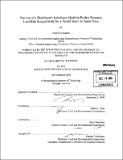The use of a distributed hydrologic model to predict dynamic landslide susceptibility for a humid basin in Puerto Rico
Author(s)
Kamal, Sameer A. (Sameer Ahmed)
DownloadFull printable version (16.06Mb)
Other Contributors
Massachusetts Institute of Technology. Dept. of Civil and Environmental Engineering.
Advisor
Rafael L. Bras.
Terms of use
Metadata
Show full item recordAbstract
This thesis describes the use of a distributed hydrology model in conjunction with a Factor of Safety (FS) algorithm to predict dynamic landslide susceptibility for a humid basin in Puerto Rico. The Mameyes basin, located in the Luquillo Experimental Forest in Puerto Rico, was selected for modeling based on the rich ensemble of soil, vegetation, topographical, meteorological and historic landslide data available. The basin was parameterized into the TIN-based Real-time Integrated Basin Simulator (tRIBS) with particular emphasis on vegetation parameters for broadleaf evergreen trees in tropical climates. The basin was forced with precipitation data that included a synthesized rainfall event likely to result in a landslide based on rainfall intensity-duration thresholds. The basin's response was assessed mainly in terms of soil moisture and values of selected vegetation parameters, which served as the dynamic inputs into the FS algorithm. (cont.) An off-line FS algorithm was developed and tested using typical values for parameters encountered in the Mameyes basin. Sensitivity analyses indicated that slope angle, soil cohesion and soil moisture were the most sensitive parameters in this FS algorithm. When the tRIBS / FS Algorithm combination was employed over the entire basin, landslides were indicated in 48 out of 13,169 modeled locations. The spatial distribution of landslides compared favorably to a static landslide susceptibility map developed in previous work by Lepore et al. (2008b) while the temporal distribution of landslides was correlated with rainfall events. Landslides were predicted over a range of slope angle values, including on relatively gentle slopes where the modeled soil moisture drove the instability. The results demonstrate that the tRIBS/FS algorithm combination developed in this work is able to capture the key dynamics associated with slope stability, specifically the interactions between the slope angle and the soil moisture state.
Description
Thesis (Env. E.)--Massachusetts Institute of Technology, Dept. of Civil and Environmental Engineering, 2009. "September 2009." Cataloged from PDF version of thesis. Includes bibliographical references (p. 86-91).
Date issued
2009Department
Massachusetts Institute of Technology. Department of Civil and Environmental EngineeringPublisher
Massachusetts Institute of Technology
Keywords
Civil and Environmental Engineering.